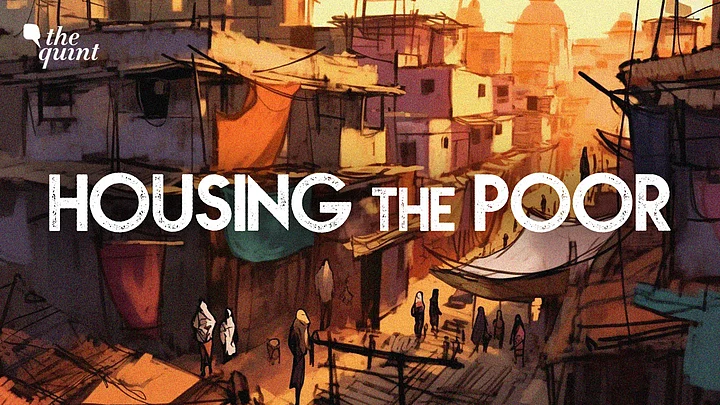Ahead of the upcoming Mumbai municipal elections, the Maharashtra government, on Thursday, 25 May, released a government resolution (GR) stating that slum dwellers with valid documents between 2000 and 2011 will get houses at the cost of ₹2.5 lakh per unit under the government's slum rehabilitation scheme.
"This is a day of Diwali for Mumbaikars and Mumbai's poor," Ashish Shelar, Bharatiya Janata Party's Mumbai chief, told reporters.
The GR informs that the decision to rehabilitate slum dwellers who can prove their slums existed between 1 January 2000 to 1 January 2011, was taken on 16 May 2018 by the then BJP-Shiv Sena government when Devendra Fadnavis was the chief minister. The owners of slums before 2000 qualify for rehabilitation free of cost.
Fadnavis, who is the current deputy CM and housing minister, told reporters,
"According to the court order, slum dwellers between 2000 and 2011 can be given houses at a price and not free of cost. The rates for that had to be decided, which we have done now. We will be giving them a house at the cost of ₹2.5 lakh. Further, they will be eligible for PMAY (Pradhan Mantri Awas Yojana), therefore they won't face much financial burden."
While both Shelar and Fadnavis attacked the previous Maha Vikas Aghadi government for not taking action on setting the price, housing minister in the Uddhav Thackeray-led MVA government, Jitendra Awhad, countered their claim saying the subcommittee chaired by him had proposed the ₹2.5 lakh figure in 2022 itself. "This government has continued with that figure," he tweeted.
The Quint was able to verify Awhad's claim by looking at news reports from 3 February 2022 – the day the announcement was made.
"An important meeting was held today under the chairmanship of Jitendra Awhad. All the officials of slum redevelopment project were present at the meeting ... He (Awhad) informed that a rate of ₹2.5 lakh has been fixed for slum dwellers who want to get a house," News18 Lokmat had reported at the time.
Bilal Khan, housing activist with the Ghar Bachao - Ghar Banao Andolan, told The Quint that he isn't aware of the court order that the government is citing to justify the cost of ₹2.5 lakh per unit. However, he added that the slum dwellers will mostly not face a problem in raising this money.
Rehabilitation Scheme Developers-Oriented
Khan raised apprehensions about another kind of cost though. He said that in high-rises the maintenance cost is very high and not always affordable for the low-income households.
Another concern that housing activists express is the low quality of structures and how densely the housing units are packed. The more tenements the developer builds for the slum dwellers, the more houses they can construct for the open market aimed at the rich (the technical term for this is Transferable Development Rights).
"The scheme is developer-oriented. If there is no profit for the developers, they wouldn't get into it," Hussain Indorewala, assistant professor at Kamla Raheja Vidyanidhi Institute for Architecture and Environmental Studies, told The Quint.
Lack of Ventilation, Sunlight and Open Spaces
The SRA (Slum Rehabilitation Authority) houses lack proper ventilation and natural light. According to a survey by Mumbai Metropolitan Region Authority's Environment Improvement Society in 2018, one in ten residents in the SRA settlements in Govandi and Mankhurd suffered from tuberculosis.
Indorewala says that the SRA societies have no concept of open spaces. Khan concurs saying due to compromises on ventilation and open spaces, the Mahul and Lallubhai Compound settlements have become susceptible to contagious diseases.
The slum rehabilitation scheme was started with the aim of improving living conditions of the slum dwellers. But the housing activists question whether that aim has been fulfilled.
Need for Affordable Housing
Indorewala faults the scheme on quantitative grounds too. When the Shiv Sena-BJP government announced the scheme in 1995, a lofty goal of constructing 8 lakh units within the span of 5-6 years was set. However, the scheme has fallen short of that target even after almost three decades.
"The scheme has led to breaking more houses than making ones," says Indorewala drily. When the developer prepares a list of eligible slum dwellers, called Annexure 2, the ones who don't make to the list are evicted from the basti and their houses demolished. The people who are thus displaced, look for rented accommodations in the neighbouring bastis, usually at a higher rent than normal as the landlords there raise the rents in anticipation of this demand. Khan also claims that some slum dwellers are deliberately left of the list so that the authorities can demand bribes from them later for inclusion.
Indorewala says that the rehabilitation scheme tries to fix the "slum problem" instead of the housing problem. He suggests that more affordable housing should be created where people can move voluntarily.
"People say there is no land but there is a lot of land. There is land outside greater Mumbai, in the MMRD region. There is land in the island city. The real problem is the approach that the State should not spend money on housing for the poor, which has led to complete privatisation of housing," asserts Indorewala.
(At The Quint, we question everything. Play an active role in shaping our journalism by becoming a member today.)
